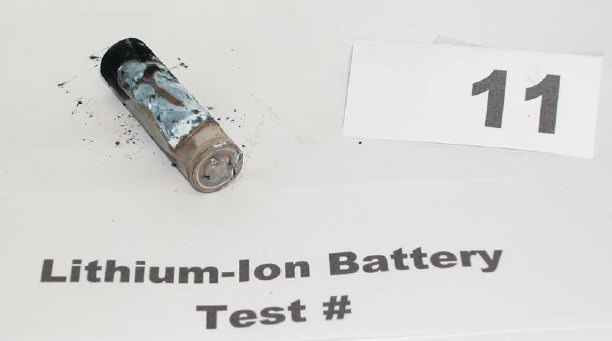Are Nuclear Reactions Causing Boeing Dreamliner Battery Fires?

Boeing 787 Dreamliner at Boston’s Logan International Airport Jan. 14, 2013 (Photo: Brian Snyder, Reuters)
Jan. 17, 2013 – By Steven B. Krivit –
Boeing’s new 787 Dreamliners use high-capacity lithium-ion batteries. These batteries have materials similar to those used in the most common type of low-energy nuclear reaction experiment. Boeing is considering LENRs for future aerospace applications. On June 22 and 23, 2011, Boeing representatives met with NASA and the Federal Aviation Authority to discuss such applications. Will they meet again to consider the possible relationship between the battery fires and LENRs?
The Federal Aviation Administration grounded all U.S.-operated Boeing 787 Dreamliners on Wednesday as a result of unexplained lithium-ion aircraft battery fires. Two Boeing 787s have experienced battery fires in nine days. A battery fire occurred last week at Boston’s Logan International Airport, and another fire took place as an All Nippon Airways 787 flew over Japan this week.
What is a lithium-ion battery? It is an electrolytic device with a cathode, an anode, and an electrolyte comprising a lithium salt and materials that provide sources of hydrogen.
What is the most common type of low-energy nuclear reaction experiment? It is an electrolytic device with a cathode, an anode, and an electrolyte comprising a lithium salt and materials that provide sources of hydrogen.
LENRs are weak interactions and neutron-capture processes that occur in nanometer-to-micron-scale regions on surfaces in condensed matter at room temperature. Some researchers believe these reactions are caused by a “cold fusion” process; however, the reactions can be explained by conventional, though unexpected, nuclear physics.
Theorist Lewis G. Larsen has been watching the unexplained lithium-ion fires with interest, as shown by his July 16, 2010, slide presentation, but he declined to speak with New Energy Times on the matter.
In his slides, Larsen writes about how lithium metal dendrites, a type of fractal structure, can grow inside lithium-ion batteries, even when the batteries are not in use.
He writes that “such dendrites are well-known to sometimes short-out electrically, rapidly discharging current arcs into nearby battery structures, creating local physical damage.”
According to Larsen’s slides, a lithium-ion battery has all the ingredients for LENRs, and they are close to one another.
“If a violent electrical discharge from a dendrite tip suddenly produces high local electric fields,” Larsen wrote, “then e –> e* [a heavy electron is formed which provides the starting point for the nuclear reaction] and voila!”
Larsen and his co-author, Allan Widom, published a paper in 2006 in European Physical Journal C – Particles and Fields that depicted a lithium-based reaction chain that could lead to unusually high energy releases.
In his slides, Larsen mentions that there have been poorly understood catastrophic failures of lithium-ion batteries and battery-packs for many years. He cites a May 14, 2009, Hewlett-Packard recall of 70,000 laptop batteries for what the company called a “fire hazard.”
Larsen cites the Jan.1, 2008, ruling from the Department of Transportation for spare lithium-ion batteries in carry-on and checked baggage. He also cites the Toyota Prius that was owned by Central Electric Power Cooperative of Columbia, South Carolina, which was modified to use lithium-ion batteries. Larsen writes that it was destroyed by an unexplained fire during a routine test drive on June 7, 2008.

FAA Lithium-Ion Battery Fire Test
In a 2006 slide presentation, Harry Webster, with the Federal Aviation Administration at the William J. Hughes Technical Center at the Atlantic City International Airport, N,J., reported an April 1999 aircraft cargo fire in which a pallet of lithium primary batteries on a loading ramp was dropped and caught fire. Webster wrote that there was no external ignition source.
He reported another aircraft cargo incident in Memphis, Tenn. Baggage handlers smelled smoke coming from one of the cargo containers. As they off-loaded the container from the aircraft, the container burst into flames on the ramp.
New Energy Times asked Keith Holloway, a public affairs officer with the National Transportation Safety Board today, whether NTSB was looking into possible LENR-related issues with the lithium-ion battery incident that occurred on the Boeing 767 in Boston. Holloway said that the agency is still collecting information.
“We don’t know at this time because we are still gathering factual information,” he said. “We are not ruling out anything, nor are we highlighting anything in particular at this time. We are examining all the components that are involved.”
New Energy Times asked Holloway whether NTSB had done any investigations into any incidents with lithium-ion battery fires. He said that, in 2006, an incident occurred with a UPS freight aircraft in Philadelphia.
The NTSB report said that “the flight crew members sustained minor injuries, and the airplane and most of the cargo were destroyed by fire after landing.”
New Energy Times asked Lori Gunter, a public affairs officer with Boeing today, whether Boeing was looking into possible LENR-related issues with the Boston lithium-ion battery incident.
“That is something I cannot answer,” Gunter said. “The specific events are under investigation by regulatory authorities; we’re a party to that investigation, and that means we cannot discuss specific details about the investigation.”
Gunter said that NTSB is the investigating authority for the event in Boston and the Japan Transport Safety Board is the investigating authority for the event in Japan.
On Aug. 3, 2012, New Energy Times wrote a news story on a research report “Subsonic Ultra Green Aircraft Research Phase-II: N+4 Advanced Concept Development,” written by Marty K. Bradley and Christopher K. Droney of Boeing Research and Technology and prepared for NASA Langley Research Center.
Questions? Comments? Submit a Letter to the Editor.

